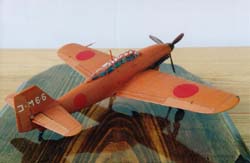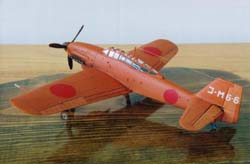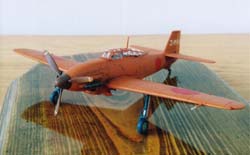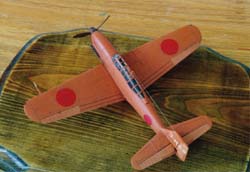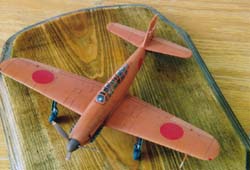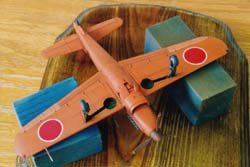Building Tamiya's Aichi M6A1-K Nanzan (Seiran Kai) in 1/72 | 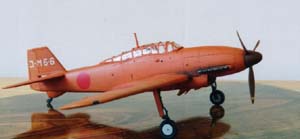 | Introduction The Nanzan followed the production of the Seiran, the latter, a floatplane, being designed to be carried by submarine from which it could be launched for attack. The land-based Nanzan was supposed to expedite flight testing of the Seiran, and it was used later as a trainer aircraft. The Kit The box contains one sprue of grey plastic, two small sprues of clear plastic parts, and a decal sheet whose contents can be used for either of the two schemes shown in the instructions. The quality of the molding is high with no flash or flaws, although the clear parts for the canopy are a little thick. I started with the interior. Mikeshís book on Japanese cockpit interiors calls for N.2 and AN 3/2: fairly dark green shades. I used a mixture of U.S. interior green and Mitsubishi interior green, which darkened up considerably following an application of burnt umber oil wash. The pieces for the cockpit interior fit together easily and are well designed for construction. In addition to the green, I used dark grey, silver, red and yellow to add detail to the interior. At this point, I added the decals for the instrument panels and the seatbelts. I sprayed the interior of the fuselage with the green, glued in the cockpit subassembly, bulkhead and instrument panel, and glued the fuselage halves. All the interior pieces fit well inside the fuselage. I glued the upper and lower pieces for the wings and added that subassembly to the fuselage. I am still prone to leaving seams despite the excellent fit of this kit, so I filled them with several application of Mr. Surfacer (both 1000 and 500), followed by a couple of airbrush applications of the same. I followed this up by re-scribing the few panel lines that had been erased in the filling and sanding process. Once this was completed I added the radiator subassembly, the horizontal tail parts, the rear wheel subassembly, and the small piece atop the tailfin. I sprayed the wheel wells and the inside of the landing gear doors with the same green I used for the interior. I wanted to keep this build fairly simple so I chose the all-over orange scheme. At this point, I went to remove the cockpit canopy from the sprue and I cracked it. My attempts to push-mold a new one using clear plastic proved futile, so there was nothing for it but to purchase another kit. Since that time, I picked up a Seiran MPM kit for a dollar, so hopefully I can use that canopy on the canopy-less extra kit I now own! I masked the canopy using the E-Z Mask aftermarket product, which I liked. I stuffed Parafilm inside the wheel wells and inside the radiator to protect the grille, and sprayed the entire model with Milwaukee Road Orange, a Poly Scale product from their railroad colours line. I had considered using international orange but that was too bright and red. I painted the propeller and spinner cocoa-brown and added the landing gear and the exhaust pipes. I mixed a little white with the orange paint and used it on the fabric surfaces. This was definitely taking some artistic license because I am not sure if that appearance is accurate. However, I wanted to give some variation to the overall orange scheme. The decals looked a little thick on the backing paper but I found they went down well on top of a couple of coats of Future. I gave the entire model a coat of Testors Clear Flat in preparation for the oil wash: I used Turpenoid mixed with burnt umber oil paint. This seeped nicely into the panel lines and the corners of the wheel wells. Following this, I used some pastel chalks to make some staining around the exhausts. Finally, I used some 0.005-inch wire to make a radio wire. Conclusion This is an excellent kit that builds up easily into a fine looking model. Further, this kit is fairly inexpensive (Just as well since I had to get two of them!): I have seen it selling for about $10. Highly recommended. References -
Robert C. Mikesh. "Japanese Aircraft Interiors 1940-1945." Monogram Aviation Publications, MA, USA. 2000. | 








|

